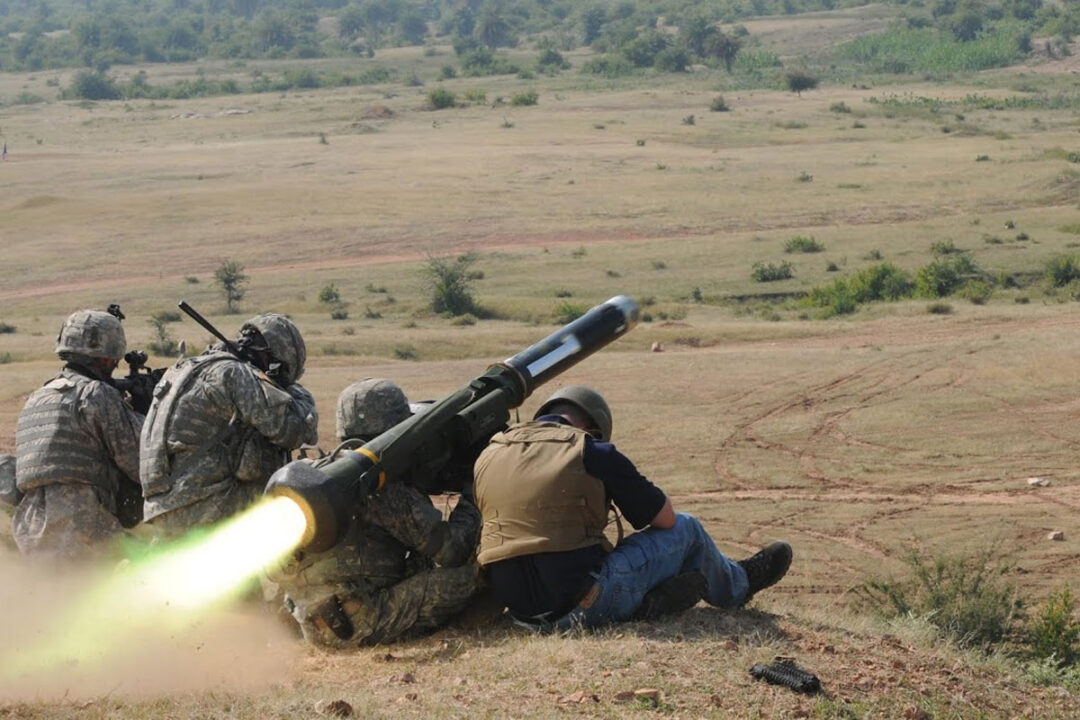Brussels, (Brussels Morning) – American-made portable anti-tank missile system FGM-148 Javelin, or Advanced Anti-Tank Weapon System-Medium (AAWS-M), has been in service since 1996. The Russian invasion of Ukraine dominates television and social media in a nation rich with mobile phone cameras and major media sources. #Ukraine, #UkraineRussiaWar, and #UkraineWar hashtags on Twitter provide a general chronology of current firefights. Against this context, the Javelin missile symbolises Ukrainian resistance. Let’s find out about their use.
What is the FGM-148 Javelin?
The Javelin missile system is the product of a partnership between Raytheon and Lockheed Martin, which was created to develop and manufacture the design. The FGM-148 Javelin is a man-portable anti-tank guided missile and deployable fire-and-forget medium-range missile system developed and manufactured in the United States. Because of its small size and low weight, the Javelin is perfectly suited for operation by a single soldier in any circumstance.
The Javelin has been proven effective in battle by the U.S. and allied troops, Marines, and Special Forces when deployed in Afghanistan and Iraq. Eleven nations have decided to go with the Javelin anti-armour system to fulfil their needs. Secondary capabilities of the Javelin include those that allow it to engage helicopters and ground combat locations. Its direct-attack capabilities will enable it to engage targets bunkered or protected by an overhead cover because its “soft launch” may be used even from inside buildings and other enclosed battle situations. The gunner’s exposure to the opponent is reduced because of the soft launch signature, which results in increased survivability.
Read More: List of All Cities Subject To Possible Nuclear Strike (Find Is Your City Included?)
FGM-148 Javelin Use in Warzones
The FGM-148 Javelin is a man-portable antitank guided missile (ATGM) system with a “fire and forgets” operation mode and an effective range of 2.5 kilometres. It was developed to be effective against highly armoured vehicles like main battle tanks and military vehicles with a thinner layer of protection. Other targets, such as fortifications, bunkers, and helicopters, are also within the weapon’s capabilities. In 1996, it became operational for the first time with the armed forces of the United States. During the Russian invasion of Ukraine in 2022, the Ukrainian armed forces heavily used Javelin missiles in warfare. The missiles proved very effective against Russian main battle tanks and other armoured vehicles.
Use of Javelin in Russia-Ukraine War
The United States has provided Ukraine with Javelin anti-tank missiles in large quantities since 2018. This aids Ukraine’s defence against invading Russian troops. In the wake of Russia’s annexation of Crimea in March 2018, the U.S. State Department gave the go-light for Javelin sales to Ukraine in October 2019, October 2021, and January 2022. 41 A new assistance deal signed into law by President Joe Biden in March 2022 promised to supply 2,000 Javelin missiles to the Ukrainian armed forces.
Specifications of the Javelin
The Javelin weighs 22.1 kg, measures 1.2 m, and has a diameter of 127 mm. Variants vary. The missile has a single 8.4 kg tandem-charge HEAT warhead. The U.S. has “demonstrated performance to 4,000 meters in typical operating scenarios” despite its 2,500-meter certified range.
Top assault and direct attack modes fly at 140 m/s and 150 m, and 50 m, respectively. U.S. military training materials say the Javelin “penetrates all known armor, far over 30 inches [762 mm] of rolled homogeneous steel.”
Command Launch Units launch Javelins (CLU). Passive infrared navigation helps the 6.4 kilogram CLU track targets. The day sight has 4x magnification and the infrared-imaging night sight has 4x and 9x. The CLU may be utilised alone or with better LRAS and ITAS-mounted surveillance systems for surveillance and target acquisition. The Lightweight CLU will enhance several characteristics.
The missile is a “fire-and-forget” system with automated infrared guidance, so operators may shoot and swiftly run for cover, reload, or fire again. Unlike the M47 Dragon, Javelin’s wire-guided predecessor, operators don’t have to follow the target until missile contact.
Javelin launches softly. An initial low-g motor ejects the missile from the firing tube when an operator presses the trigger. The rocket fires its primary flight motor after leaving the firing tube. The Javelin’s soft launch system prevents missile exhaust from striking the operator, allows shots from restricted places and structures, decreases shoulder-launched recoil, and reduces launch smoke trails that betray launch sites and attract counterfire.
Conclusion
Javelin is a lock-on-before-launch and self-guided missile, so you can forget about it once you fire it. For use against armoured vehicles, the system employs a top attack flight profile, which aims for thinner full armor. Still, it can also make a direct assault, which is useful against structures, targets too near for top attack, targets beneath obstacles, and helicopters. This post will go through the technical details and contemporary use of the FGM-148 Javelin in combat zones.



